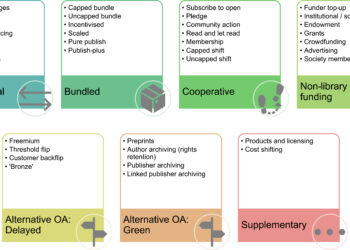
- Image via Wikipedia
We’ve all read declaration after declaration that the publishing business model is dead and needs to be replaced by a new one. So far, no one seems to have any idea exactly what that new business model should be. There’s far too much out there that resembles a certain South Park episode with no one supplying the missing step:
1. Use Web 2.0
2. ?????
3. Profit
Two individuals have recently been noted online for their Web 2.0 money-making efforts, and I thought it would be worth taking a look to see how applicable they are as examples for us all.
First, there’s the case of Amanda Palmer, singer for the Dresden Dolls, and her recent report of making $19,000 in ten hours on Twitter. She notes that she has sold 30,000 copies of her major label album this year and so far received $0 in payment for doing so. Palmer has some 30,000 Twitter followers, and used Twitter for various things like selling t-shirts, running an impromptu auction of things in her room (including empty wine bottles which sold for upwards of $300), and selling tickets to a private performance. It’s a fascinating study in how a well-established musician can use new Web 2.0 technologies to directly reach fans and profit, much like Radiohead did with their much-hyped pricing experiment. The question is, can an act that’s not already established do the same?
Palmer has been performing since 2001 and, like Radiohead, joined into the traditional music industry rat race to make a name for herself. While she isn’t getting directly paid for selling any albums, those albums and the PR department of her record label have certainly helped her build a following, which allows her to now sell her garbage on Twitter.
How does one go from playing in your Mom’s garage to reaching the same number of people that Radiohead’s efforts reached without a serious and professional PR campaign?
Oh, and Palmer also happens to be the girlfriend of Neil Gaiman, the best-selling author with a huge group of very devoted fans and over 660,000 Twitter followers. Gaiman apparently plugged Amanda’s activities on his own Twitter feed. Hmm. Guess that made things easier, but it’s kind of hard for the rest of us to follow suit.
Next there’s the case of Chris Anderson, you probably know him as the editor of Wired Magazine (but not the Wired website) and the author of “The Long Tail” and the soon-to-be-released “Free: The Future of a Radical Price.” He, like a few other members of the echo chamber, has figured out the secret to profiting from Web 2.o:
- Start a blog where you write about Web 2.0–the key is to tell people their business model is broken and they need a new one. You can just leave it there and not suggest anything new, or, like Anderson, you can put forth your theories. It seemingly doesn’t matter if those theories are failing at the business you run yourself, or if others publicly poke major holes in them. Promote your ideas on the cover of the magazine that you run.
- Turn that blog into a book–feel free to copy large portions of Wikipedia directly into your book.
- Hit the lecture circuit–the NY Times says he gives 50 speeches a year at $35,000-50,000 per speech. That works out to at least $1.75 million, although I think that figure is over-inflated. I spoke with someone who would know, and they estimated that Anderson gets closer to $10K per talk–but that’s still a nice income of $500K per year in addition to your book sales and your day job. This plan, of course, assumes that the market will support an unlimited number of Web 2.0 lecturers.
So, in summary, the secret to profiting from Web 2.0 is no longer what we thought–it used to be that everything was going to be free, and we’d all make money by selling t-shirts to one another. Instead, we all need to toil for years without pay to build a following, then sell our garbage online to that following (getting a famous boyfriend or putting yourself on magazine covers can also help). Then we hit the lecture circuit to tell everyone else how to sell garbage.
Okay, so maybe those aren’t examples that most of us can emulate. Very few of us control national magazines, or have a penchant for staging our own deaths. But what strikes me about both stories is that, despite the new technologies involved, the things that are generating revenue here are decidedly old-fashioned. Palmer is essentially selling souvenirs and doing what musicians did before technologies like sheet music or recordings existed, making money through live performance. Anderson plans to give his book away for free, one assumes in an effort to promote his very successful lecture business. He’s going back further than Palmer, and using a business model that dates back to Homer and the oral tradition.
In both cases, there’s no money being made from Web 2.0 itself. The technology is being used as an advertising means to sell very traditional goods and services, the kinds of personal things you’d think would be outdated in our increasingly wired world. Web 2.0 is a tool to facilitate those analog businesses, not a business in itself. And that’s something I think gets lost in the hype and the goldrush/sky-is-falling mentality that surrounds Web 2.0. A clever technology is not enough. A social network is not enough. Building an audience is not the same thing as building revenue.
The Web 2.0 world is filled with start-ups (and well-established companies) that are building expensive new networking ventures with no obvious business plan. The idea is that you’ll wait until they catch on, then figure out how to make money from them. And that’s where the problem lies. You actually have to have something of value that people are willing to buy. That’s the missing step #2 above. Targeted use of these new technologies can then be a very effective way of enhancing your business, but they’re empty on their own.
Discussion
5 Thoughts on "Successful Web 2.0 Business Models"
Step 2 – get bought (or better still invested in) by Google, Microsoft or Amazon (Apple won’t do this – not invented by them and Yahoo cannot anymore – not cool enough for the startup kiddies).
Seriously, VC economics* are doing a good job of mucking up established business models without actually indicating when anything will follow in their wake. Clay Shirky’s thesis is that all this has happened before with the printing press, and years of chaos ensued. Back then the economic drivers of the world were not built around media so the chaos was not an overwhelming problem. But today…
*dodgy relative of voodoo economics
Very funny, and insightful. Thanks.


